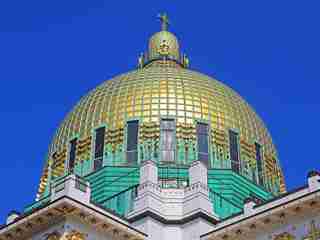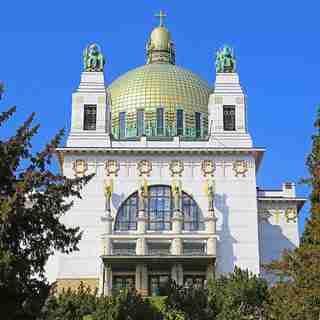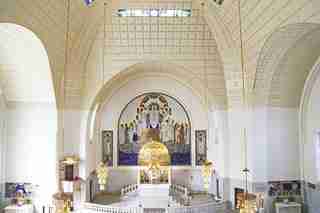Inside Vienna's Church of St. Leopold and the Sanatorium Purkersdorf

dam-images-daily-2015-04-tae-vienna-otto-wagner-josef-hoffmann-vienna-02.jpg
Often called the father of modernism, Wagner experimented with new shapes and forms of ornamentation. Here, detail of the church’s dome.

dam-images-daily-2015-04-tae-vienna-otto-wagner-josef-hoffmann-vienna-01.jpg
Otto Wagner’s Church of St. Leopold in Vienna is located at the center of a large medical complex, which Wagner designed at the turn of the 20th century. The church reflects historic changes in artistic, social, and scientific attitudes at the time.

dam-images-daily-2015-04-tae-vienna-otto-wagner-josef-hoffmann-vienna-04.jpg
Interiors were meant to feel restful and to avoid triggering anxiety. Corners were rounded, the confessionals were made more open, and side exits were added so that patients could easily leave the building.
dam-images-daily-2015-04-tae-vienna-otto-wagner-josef-hoffmann-vienna-03.jpg
Wagner enlisted many artists and artisans who were part of Vienna's Secessionist movement to help decorate the building. The sculptural angels atop the entry portico were created by Othmar Schimkowitz.
dam-images-daily-2015-04-tae-vienna-otto-wagner-josef-hoffmann-vienna-06.jpg
Even the inside of the dome reflected a new age of controlled ornamentation. The ceiling alludes to the sky above with its blue-glass panels representing the four apostles.
dam-images-daily-2015-04-tae-vienna-otto-wagner-josef-hoffmann-vienna-07-new.jpg
The church dome connects to a vaulted ceiling; at the far end of the room is an organ built by Franz Josef Swoboda.
dam-images-daily-2015-04-tae-vienna-otto-wagner-josef-hoffmann-vienna-05.jpg
A detail of the altar at the center of the church.
dam-images-daily-2015-04-tae-vienna-otto-wagner-josef-hoffmann-vienna-09.jpg
Behind the organ is a stained-glass window by Koloman Moser.
dam-images-daily-2015-04-tae-vienna-otto-wagner-josef-hoffmann-vienna-08.jpg
Doorways are framed with rounded wood casements that convey openness.
dam-images-daily-2015-04-tae-vienna-otto-wagner-josef-hoffmann-vienna-10.jpg
Wagner designed the pews to have no sharp edges.
dam-images-daily-2015-04-tae-vienna-otto-wagner-josef-hoffmann-vienna-11.jpg
Around the same time Wagner was building the Church of St. Leopold, his star pupil Josef Hoffmann was designing the Sanatorium Purkersdorf, a health spa and recuperation center for those recovering from physical or mental illnesses.
dam-images-daily-2015-04-tae-vienna-otto-wagner-josef-hoffmann-vienna-12.jpg
The clarity of structure and function of ornament in Hoffmann’s entry articulate the new attitudes taking hold in the 1900s.
dam-images-daily-2015-04-tae-vienna-otto-wagner-josef-hoffmann-vienna-14.jpg
Ornamentation is limited, and a new graphic quality lightens the perception of the masonry building.
dam-images-daily-2015-04-tae-vienna-otto-wagner-josef-hoffmann-vienna-13.jpg
Detail of Hoffmann’s simple but elegant glass canopy.
dam-images-daily-2015-04-tae-vienna-otto-wagner-josef-hoffmann-vienna-15.jpg
Traditional window trim is pared down to a simple, continuous graphic that turns the corner of the building.
dam-images-daily-2015-04-tae-vienna-otto-wagner-josef-hoffmann-vienna-16.jpg
Hoffmann’s obsession with the design of the total environment is evidenced in the hotel-like common space of the sanatorium, with furnishings by the Wiener Werkstätte, in which he was deeply involved.
dam-images-daily-2015-04-tae-vienna-otto-wagner-josef-hoffmann-vienna-17.jpg
A windowed passageway opens the interiors to the surrounding landscape.
dam-images-daily-2015-04-tae-vienna-otto-wagner-josef-hoffmann-vienna-18.jpg
Hoffmann’s atriumlike stairway creates a gracious vertical circulation.